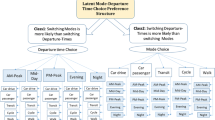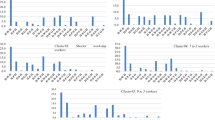Abstract
The purpose of the current research effort is to develop a framework for a better understanding of commuter train users’ access mode and station choice behavior. Typically, access mode and station choice for commuter train users is modeled as a hierarchical choice with access mode being considered as the first choice in the sequence. The current study proposes a latent segmentation based approach to relax the hierarchy. In particular, this innovative approach simultaneously considers two segments of station and access mode choice behavior: Segment 1—station first and access mode second and Segment 2—access mode first and station second. The allocation to the two segments is achieved through a latent segmentation approach that determines the probability of assigning the individual to either of these segments as a function of socio-demographic variables, level of service (LOS) parameters, trip characteristics, land-use and built environment factors, and station characteristics. The proposed latent segment model is estimated using data from an on-board survey conducted by the Agence Métropolitaine de Transport for commuter train users in Montreal region. The model is employed to investigate the role of socio-demographic variables, LOS parameters, trip characteristics, land-use and built environment factors, and station characteristics on commuter train user behavior. The results indicate that as the distance from the station by active forms of transportation increases, individuals are more likely to select a station first. Young persons, females, car owners, and individuals leaving before 7:30 a.m. have an increased propensity to drive to the commuter train station. The station model indicates that travel time has a significant negative impact on station choice, whereas, presence of parking and increased train frequency encourages use of the stations.

Similar content being viewed by others
References
Appleyard, B.: Sustainable and healthy travel choices and the built environment. Transp. Res. Rec. 2303(1), 38–45 (2012)
Bergman, A., Gliebe, J., Strathman, J.: Modeling access mode choice for inter-suburban commuter rail. J. Public Transp. 14(4), 23–42 (2011)
Bhat, C.: Work travel mode choice and number of non-work commute stops. Transp. Res. Part B 31(1), 41–54 (1997)
Cervero, R., Gorham, R.: Commuting in transit versus automobile neighborhoods. J. American Plan. Assoc. 61(2), 210–225 (1995)
Debrezion, G., Pels, E., Rietveld, P.: Choice of departure station by railway users. Eur. Transp. XIII(37), 78–92 (2007)
Debrezion, G., Pels, E., Rietveld, P.: Modelling the joint access mode and railway station choice. Transp. Res. Part E 45(1), 270–283 (2009)
Eluru, N., Bhat, C.R.: A joint econometric analysis of seat belt use and crash-related injury severity. Accid. Anal. Prev. 39(5), 1037–1049 (2007)
Eluru, N., Sener, I.N., Bhat, C.R., Pendyala, R.M., Axhausen, K.W.: Understanding residential mobility: a joint model of the reason for residential relocation and stay duration. Transp. Res. Rec. 2133, 64–74 (2009)
Eluru, N., Chakour, V., El-Geneidy, A.: Travel mode choice and transit route choice behavior in Montreal: insights from mcgill university members commute patterns. Public Transp. 4(2), 129–149 (2012)
Fan, K., Miller, E., Badoe, D.: Modeling rail access mode and station choice. Transp. Res. Rec. 1413, 49–59 (1993)
FHWA: Status of the Nation’s Highways, Bridges, and Transit. FHWA, Washington, DC (2002)
Givoni, M., Rietveld, P.: The access journey to the railway station and its role in passengers’ satisfaction with rail travel. Transp. Policy 14(5), 357–365 (2007)
Hodges, T.: Public Transportation’s Role in Responding to Climate Change (2009)
Keijer, M.J.N., Rietveld, P.: How do people get to the railway station? The Dutch experience. Transp. Plan. Technol. 23(3), 215–235 (2000)
Krygsman, S., Dijst, M., Arentze, T.: Multimodal public transport: an analysis of travel time elements and the interconnectivity ratio. Transp. Policy 11(3), 265–275 (2004)
Liou, P.S., Talvitie, A.P.: Disaggregate access mode and station choice models for rail trips. Transp. Res. Rec. 526, 42–65 (1974)
Park, S., Kang, J.: Factors that influence walking and biking to the station: modeling commuter rail user’s access mode choice. In: Proceedings of the Transportation Research Board 87th Annual Meeting, 2008
Pinjari, A., Eluru, N., Bhat, C., Pendyala, R., Spissu, E.: Joint model of choice of residential neighborhood and bicycle ownership: accounting for self-selection and unobserved heterogeneity. Transp. Res. Rec. 2082(-1), 17–26 (2008)
Pinjari, A., Pendyala, R., Bhat, C., Waddell, P.: Modeling residential sorting effects to understand the impact of the built environment on commute mode choice. Transportation 34(5), 557–573 (2007)
Pinjari, A., Pendyala, R., Bhat, C., Waddell, P.: Modeling the choice continuum: an integrated model of residential location, auto ownership, bicycle ownership, and commute tour mode choice decisions. Transportation 38(6), 933–958 (2011)
Rajamani, J., Bhat, C., Handy, S., Knaap, G., Song, Y.: Assessing impact of urban form measures on nonwork trip mode choice after controlling for demographic and level-of-service effects. Transp. Res. Rec. 1831(-1), 158–165 (2003)
Sider T., Alam, A., Zukari, M., Dugum, H., Goldstein, N., Eluru, N., Hatzopoulou, M.: Land-use and socio-economics as determinants of traffic emissions and individual exposure to air pollution. J. Transp. Geogr. (2013). doi:10.1016/j.jtrangeo.2013.08.006
van Wee, B., van Baren, R.: Preferences for modes, residential location and travel behaviour: the relevance of land-use impacts on mobility. Eur. J. Transp. Infrastructure Res. 2(2), 305–315 (2002)
Waddell, P., Bhat, C., Eluru, N., Wang, L., Pendyala, R.: Modeling interdependence in household residence and workplace choices. Transp. Res. Rec. 2003, 84–92 (2007)
Wardman, M., Whelan, G. A.: Using Geographical Information Systems to Improve Rail Demand Models (1999)
Acknowledgments
The corresponding author would like to acknowledge financial support from Natural Sciences and Engineering Research Council (NSERC) of Canada under the Discovery Grants program for undertaking the research. The authors would like to extend their appreciation to Daniel Bergeron from Agence Métropolitaine de Transport (AMT) and Prof. Ahmed El-Geneidy from McGill University for sharing the data used in our study. The authors would also like to acknowledge useful feedback from three anonymous reviewers and the editor Prof. David Hartgen.
Author information
Authors and Affiliations
Corresponding author
Rights and permissions
About this article
Cite this article
Chakour, V., Eluru, N. Analyzing commuter train user behavior: a decision framework for access mode and station choice. Transportation 41, 211–228 (2014). https://doi.org/10.1007/s11116-013-9509-y
Published:
Issue Date:
DOI: https://doi.org/10.1007/s11116-013-9509-y




